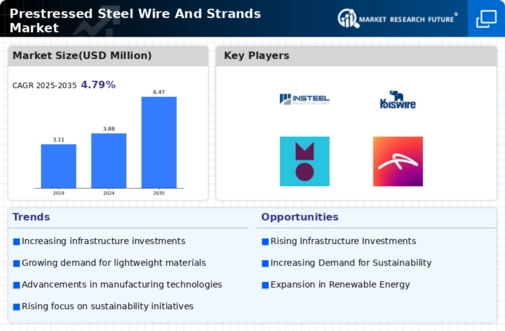Market Share
Prestressed Steel Wire Strands Market Share Analysis
The global market for prestressed steel wire and strands is witnessing significant growth, primarily propelled by the escalating demand for prestressing steel across various critical end-user applications. These applications encompass the railroad industry, construction equipment, bridges, flyovers, energy-related projects, and other sectors. Prestressing steel, characterized by its high strength and used in various forms like wire, rod, bars, and strands, plays a pivotal role in prestressed concrete (PC) applications. The surge in demand for prestressed steel is attributed to its exceptional properties, including high strength, adequate ductility, and bendability crucial at harping points and near the anchorage. Other notable attributes include high bond strength required for pre-tensioned applications, low relaxation to minimize losses, resistance to tension, and crucially, corrosion resistance.
Prestressed steel finds widespread use in the construction sector, contributing to the building of bridges, industrial and residential structures, railway projects, and wind power stations. Pressed steel wires and strands, on the other hand, are utilized in applications involving prestressed concrete structures, reinforcing large-span bridges on railways and highways, overhead crane beams, rock-soil anchoring projects, industrial buildings, stadiums, mines, and more. The application of prestressed concrete, known for its durability and superior construction capabilities, spans a diverse range, including various bridge types, wind towers, and high-rise buildings. The growing incorporation of prestressed steel in construction projects, driven by the need to withstand high mechanical stresses, is anticipated to fuel the global market's growth in the foreseeable future.
Furthermore, the construction industry's expansion in the emerging economies of Asia-Pacific is poised to positively impact the global market. The robust growth of the construction sector in this region is driven by the increasing demand for commercial spaces, particularly in developed and developing countries. Key sectors such as Information Technology (IT), Banking, Financial Services, and Insurance (BFSI), and telecommunications are experiencing substantial growth, leading to an upswing in demand for construction projects. This surge in construction activity is a significant driver for the global prestressed steel wire and strand market.
Taking a closer look at the United States, the value of construction in January 2021 amounted to USD 712,951 million for residential construction and USD 447,027 million for non-residential construction, according to the US Census Bureau. The historical data depicted in the graph below illustrates the spending trends in the US construction sector. Construction spending, as measured by monthly estimates of the total dollar value of construction work on new structures or improvements to existing structures, encompasses both private and public sectors in the US. This data underscores the substantial investment and activity in the construction sector, which, in turn, influences the demand for materials such as prestressed steel wire and strands.
The global prestressed steel wire and strands market are witnessing significant growth due to increased demand across various construction applications and sectors. The exceptional properties of prestressed steel, coupled with its versatile applications, position it as a vital component in modern construction projects. The ongoing expansion of the construction industry, particularly in emerging economies, and the robust construction spending trends, as evidenced by the US market, affirm the promising trajectory of the prestressed steel market on a global scale.







Leave a Comment